Toplines
US President Donald Trump’s October 17 meeting with Ukrainian President Volodymyr Zelensky reportedly ended with Trump supporting a ceasefire on the current frontlines and not Russian President Vladimir Putin’s demands that Ukraine cede territory in Donetsk Oblast to Russia. Western reporting, citing sources with knowledge of the Trump-Zelensky meeting, indicates that Trump or a “Trump aide” initially supported Putin’s demand that Ukraine cede Donetsk Oblast to Russia but that Trump later proposed a ceasefire freezing the current frontline by the end of the meeting.[1] Trump told journalists that he did not tell Zelensky that Ukraine must cede Donetsk Oblast to Russia.[2] Trump has subsequently publicly stated that Ukraine and Russia should freeze the current frontline.[3] Trump reportedly discussed giving security guarantees to both Ukraine and Russia during the October 17 meeting.[4] Some Western media outlets reported that Putin offered to exchange unspecified “small areas” or “parts” of Kherson and Zaporizhia oblasts for the rest of Donetsk Oblast during his October 16 call with Trump.[5] It remains unclear if Putin offered to withdraw from parts of Kherson and Zaporizhia oblasts that Russian forces currently occupy or if Putin offered to abandon part or all of his demand that Ukraine cede unoccupied parts of the regions to Russia. It is also unclear if Putin was proposing preconditions for leader-level negotiations with Ukraine, a ceasefire, or a final peace settlement and if the parties discussed any additional conditions that Putin attached to such negotiations, ceasefire, or peace settlement.
Kremlin voices clarified Russia’s position on negotiations following Western reporting about the October 17 Trump-Zelensky meeting in order to reiterate that Russia remains committed to addressing the alleged “root causes” of the war and is unwilling to agree to a ceasefire. Kremlin Spokesperson Dmitry Peskov responded to Western media reports about Trump’s proposal for a ceasefire along the current frontline, stating that Russia has responded to the many repeated statements on this matter and that Russia’s position is “well known” and “consistent.”[6] Russian Ministry of Foreign Affairs (MFA) Spokesperson Maria Zakharova claimed that Russia has discussed the “root causes” of the war in order to ensure that a resolution to the war guarantees peace.[7] Zakharova reiterated that Putin, Russian Foreign Minister Sergei Lavrov, and “the Russian leadership as a whole” have spoken about the need to eliminate the “root causes” and that Russia is oriented around this position. Russian State Duma International Affairs Committee First Deputy Head Alexei Chepa claimed that there should not be a ceasefire along the current lines and rejected assertions that a ceasefire would allow for diplomatic negotiations to end the war.[8] Chepa claimed that Russia should conclude an agreement on building the “future world order in Ukraine” before agreeing to halt military actions. Chepa claimed that the upcoming Trump-Putin meeting in Budapest could compel Ukraine to accept the terms of a peace settlement and then Russia can finalize a ceasefire on the frontline.[9] Chepa claimed that Russia also needs security guarantees at the end of the war from the United States and alluded to Russia’s ultimatums to the United States in 2021 about NATO.[10] Chepa claimed that there are “a lot of issues,” including demands for Ukrainian neutrality, the cessation of NATO expansion, and the reduction of “certain types of weapons” (possibly referring to Russian demands for significant reductions to the Ukrainian military or the resumption of US-Russian arms control treaties).
The Kremlin has repeatedly referenced the need to eliminate the alleged “root causes” of the war in Ukraine, which Kremlin officials have defined as NATO’s eastward expansion and Ukraine’s alleged discrimination against Russian-speakers.[11] The Kremlin uses discussions about these root causes to forward Russia’s original war demands for Ukrainian neutrality, the removal of the legitimate government in Ukraine, the installation of a pro-Russian government, and changes to NATO’s Open Door Policy. Kremlin officials have also repeatedly rejected Trump’s and Zelensky’s proposals for a ceasefire on the grounds that negotiations for a final peace settlement must come first.[12] The Kremlin is likely reemphasizing Russia’s commitment to its original war aims against the backdrop of Western reporting about the October 17 Trump-Zelensky meeting in order to clarify that Trump’s position coming out of that meeting is unacceptable for the Kremlin, particularly ahead of the meeting between Russian Foreign Minister Sergei Lavrov and US Secretary of State Marco Rubio.
The Kremlin is priming the Russian people for a full victory in Ukraine whatever the cost — a domestic effort that is at odds with Putin’s reported willingness to make territorial concessions. The Kremlin has consistently reiterated throughout the war that Russia’s war demands remain unchanged and has communicated to the Russian people that Russia will achieve all these goals in Ukraine, whether militarily or diplomatically.[13] The Kremlin has not prepared Russian society to accept anything less than these demands. Russian Security Council Secretary Sergei Shoigu, who served as defense minister throughout much of the war, claimed in an interview to Kremlin newswire TASS on October 20 that occupied Ukrainian areas should not be considered “new regions” of Russia but are instead Russia’s “old regions” that have “historically” been Russian.[14] TASS framed Shoigu’s claim as referring to Donbas and “Novorossiya” — an amorphous invented region in southern and eastern Ukraine that the Kremlin has claimed is “integral” to Russia.[15] The Kremlin has conditioned Russians to expect that Russia’s illegal annexation of parts of Ukraine is permanent and that Russia cannot make any territorial concessions to Ukraine. Western media broadly reported around the August 2025 Alaska summit that Putin had offered territorial concessions in exchange for the Ukrainian surrender of the unoccupied portion of Donetsk Oblast, prompting ire from Russian officials and ultranationalist voices in the information space.[16] Russian officials and pro-Kremlin voices downplayed or dismissed the prospect of territorial concessions following Western reporting that Putin recently made a similar offer for territorial concessions to Trump.[17] Putin’s refusal to prepare the Russian people, including the important ultranationalist constituency, to make any concessions in the war in Ukraine is another indicator that he does not intend to diverge from his long-held demands in any future peace talks.
The Kremlin is leaning into its cognitive warfare effort to portray Russian forces as relentlessly advancing and a Russian victory as inevitable. This effort aims to obscure the reality that Russian forces are only making minimal gains at disproportionately high manpower costs and that Russia is unlikely to obtain its strategic objectives by force in the short- or medium-term. Ukrainian Foreign Minister Andriy Sybiha stated on October 20 that Russia is increasing its federal spending on propaganda in the 2026 budget by 54 percent compared to the 2025 federal budget.[18] ISW has also observed reports indicating that the Kremlin is significantly investing in state television outlets and traditional means of propaganda in the 2026 budget.[19] The Kremlin’s increase in state funding for mass media and propaganda notably comes as Russian federal subjects are cutting down on one-time signing bonuses for new military recruits, likely at the Kremlin’s direction and in response to struggles to maintain voluntary recruitment and the negative effects these payments are having on the Russian economy as a whole.[20] The Kremlin is trying to use the information space to portray a Russian victory in Ukraine as certain in order to push Ukraine and the West to concede to Russia’s demands. The Kremlin is heavily investing in its cognitive warfare capabilities and efforts to try to achieve its unrealistic war goals through diplomatic means. ISW has observed no indications that the Kremlin remains willing to accept anything less than Ukrainian capitulation to all of its original war demands, and the Kremlin remains willing to expend considerable amounts of manpower, materiel, time, and other resources to achieving these demands on the battlefield if needed.
The Kremlin is advancing several informational lines falsely inflating reports of Russian military advances and offensive capabilities in order to push the West and Ukraine into conceding to Russia’s territorial demands. Russian forces have been conducting infiltration missions and raising Russian flags in porous areas of the frontline in eastern Ukraine, particularly in Kupyansk, Kharkiv Oblast and in Donetsk Oblast, as part of a concerted effort to claim that these infiltration missions are actually enduring Russian territorial gains.[21] Putin and senior Russian defense officials have artificially inflated the extent of Russian gains in Ukraine in recent weeks, particularly following the August 2025 Alaska summit, using these infiltration missions and exaggerated qualitative data to lend legitimacy to their claims.[22] The Kremlin aims for these claims to penetrate the Western information space to falsely portray Russia as capable of making rapid gains on the battlefield and overwhelming Ukrainian forces, even though Russian advances are constrained to slow footpace, dependent upon large numbers of infantry, and incur heavy casualties.
Russian officials are also attempting to falsely portray ongoing limited Russian operations in the Kherson direction as the start of a new major Russian offensive in the province. Russian officials and pro-Kremlin sources have begun pushing the narrative that Russian forces have begun efforts to seize Kherson City, claiming without evidence that limited sabotage and reconnaissance activity is actually a significant offensive and that Russia occupies areas of Kherson City.[23] Kherson City’s administrative boundaries are limited to the west (right) bank of the Dnipro River, and Russian forces have not occupied areas of west bank Kherson Oblast since the successful Ukrainian counteroffensive in November 2022 that drove Russian forces to withdraw across the Dnipro River to the east (left) bank.[24] ISW has not observed indications that Russian forces are preparing for or have launched a concerted offensive effort to cross the Dnipro River and advance into west bank Kherson Oblast — an operation that would require significant manpower and materiel that Russia has not concentrated in the Kherson direction.[25] The Kremlin likely seeks to convince Ukraine and the West that Russia’s recapture of Kherson City and all of Kherson Oblast is inevitable such that Ukraine should cede these areas to Russia. The Kremlin may also seek to posture that a Russian “decision” to not seize these areas in exchange for Ukrainian withdrawal from unoccupied Donetsk Oblast would be a significant Russian concession. The Kremlin is attempting to use all available informational avenues to convince the United States, Europe, and Ukraine to acquiesce to the Kremlin’s demands by convincing them that a Russian victory in Ukraine is certain when it is anything but.
Kremlin officials are attempting to present Ukraine as the obstacle to peace to obfuscate how Putin himself has been impeding the process by insisting that Ukraine cede more territory than Russian forces currently occupy. Russian Direct Investment Fund (RDIF) CEO and key Kremlin negotiator Kirill Dmitriev claimed on October 19 that Ukraine and Europe are undermining the US-led peace process.[26] Zelensky has agreed to each of Trump’s proposed immediate ceasefires along the current front in recent months, whereas Putin has rejected every one.[27] The Kremlin has been pushing a false narrative that Russia will inevitably seize the territory it is demanding and that Ukraine therefore is responsible for protracting the war by refusing to surrender preemptively. Russian forces in reality, however, have been making creeping, marginal territorial advances at very high casualty rates because Putin has repeatedly rejected American and Ukrainian ceasefire proposals and remains determined to fight for more territory than Russia now controls.[28] Russia, not Ukraine, has repeatedly demonstrated that its refusal to compromise or engage in good faith negotiations is the reason for the lack of peace.
Key Takeaways
- US President Donald Trump’s October 17 meeting with Ukrainian President Volodymyr Zelensky reportedly ended with Trump supporting a ceasefire on the current frontlines and not Russian President Vladimir Putin’s demands that Ukraine cede territory in Donetsk Oblast to Russia.
- Kremlin voices clarified Russia’s position on negotiations following Western reporting about the October 17 Trump-Zelensky meeting in order to reiterate that Russia remains committed to addressing the alleged “root causes” of the war and is unwilling to agree to a ceasefire.
- The Kremlin is priming the Russian people for a full victory in Ukraine whatever the cost — a domestic effort that is at odds with Putin’s reported willingness to make territorial concessions.
- The Kremlin is leaning into its cognitive warfare effort to portray Russian forces as relentlessly advancing and a Russian victory as inevitable. This effort aims to obscure the reality that Russian forces are only making minimal gains at disproportionately high manpower costs and that Russia is unlikely to obtain its strategic objectives by force in the short- or medium-term.
- Russian officials are also attempting to falsely portray ongoing limited Russian operations in the Kherson direction as the start of a new major Russian offensive in the province.
- The Kremlin is attempting to use all available informational avenues to convince the United States, Europe, and Ukraine to acquiesce to the Kremlin’s demands by convincing them that a Russian victory in Ukraine is certain when it is anything but.
- Kremlin officials are attempting to present Ukraine as the obstacle to peace to obfuscate how Putin himself has been impeding the process by insisting that Ukraine cede more territory than Russian forces currently occupy.
- Ukrainian forces recently advanced in the Siversk direction. Russian forces recently advanced in the Velykyi Burluk direction.
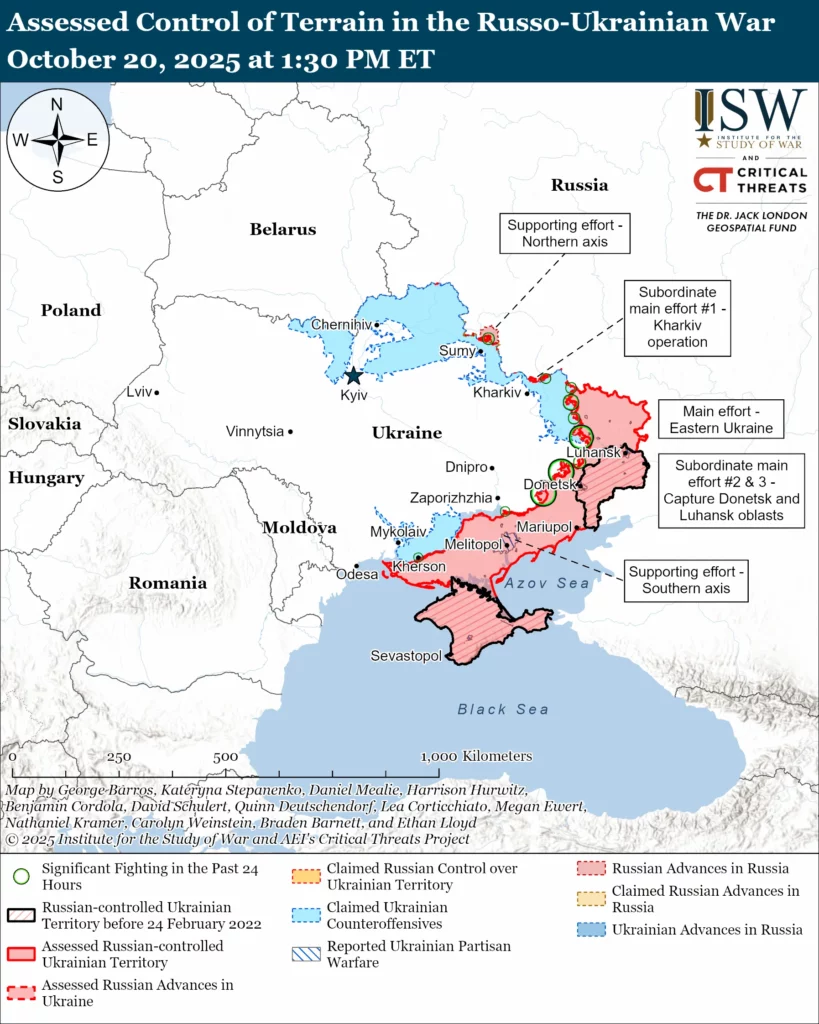
We do not report in detail on Russian war crimes because these activities are well-covered in Western media and do not directly affect the military operations we are assessing and forecasting. We will continue to evaluate and report on the effects of these criminal activities on the Ukrainian military and the Ukrainian population and specifically on combat in Ukrainian urban areas. We utterly condemn Russian violations of the laws of armed conflict and the Geneva Conventions and crimes against humanity even though we do not describe them in these reports.
Ukrainian Operations in The Russian Federation
Two industry sources told Reuters on October 20 that the Ukrainian drone strike against the Orenburg natural gas processing plant on the night of October 19 and 20 forced the plant to halt gas intake from Kazakhstan, decreasing production at Kazakhstan’s Karachaganak oil and gas condensate field by 25 to 30 percent.[29]
Russian Supporting Effort: Northern Axis
Russian objective: Create defensible buffer zones in northern Ukraine along the international border
Russian forces continued offensive operations in northern Sumy oblast on October 20 but did not advance.
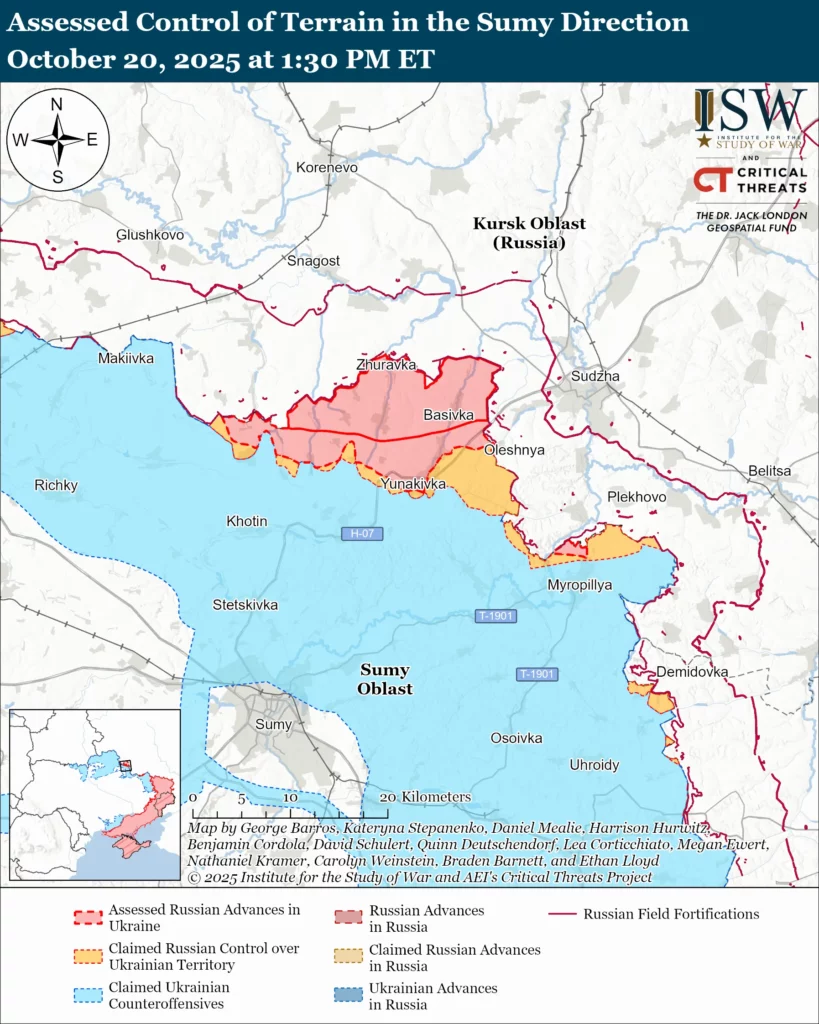
Fighting continued in unspecified areas of Kursk and Sumy Oblasts on October 19 and 20.[30] Russian milbloggers claimed that Ukrainian forces counterattacked near Kostyantynivka (north of Sumy City) and south of Yunakivka (northeast of Sumy City).[31] Chechen Republic Head Ramzan Kadyrov claimed that drone operators of the Russian 1443rd Motorized Rifle Regiment (formed during the 2022 partial reserve call up) are striking Ukrainian forces that are counterattacking near Varachyne and Novomykolaivka (both northeast of Sumy City).[32]
Order of Battle: Elements of the Russian 810th Naval Infantry Brigade (Black Sea Fleet) are reportedly operating near Oleksiivka (north of Sumy City); elements of the 22nd Motorized Rifle Regiments (72nd Motorized Rifle Division, 44th Army Corps [AC], Leningrad Military District [LMD]) are reportedly operating on the southern outskirts of Oleksiivka; and elements of the 30th Motorized Rifle Regiment (72nd Motorized Rifle Division) are reportedly operating in eastern Oleksiivka.[33]
Russian Main Effort: Eastern Ukraine
Russian Subordinate Main Effort #1
Russian objective: Push Ukrainian forces back from the international border with Belgorod Oblast and approach to within tube artillery range of Kharkiv City.
Ukrainian forces maintained positions or recently advanced in northern Kharkiv Oblast.
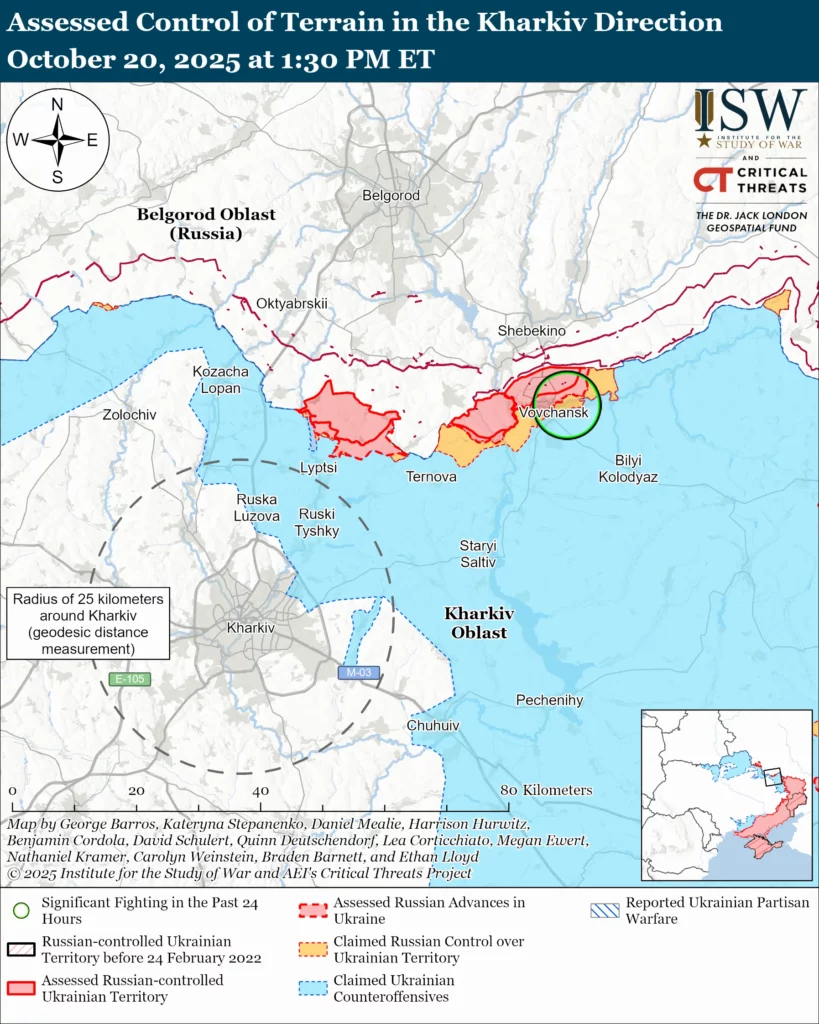
Refinement of areas under Russian claims: Geolocated footage published on October 19 indicates that Ukrainian forces maintain positions or recently advanced in southwestern Tykhe — an area in which Russian sources previously claimed that Russian forces maintained a presence.[34]
Unconfirmed claims: Russian milbloggers claimed that Russian forces advanced near Synelnykove, on the left (south) bank of the Vovcha River in Vovchansk, and near Tykhe (all northeast of Kharkiv City).[35]
Russian forces attacked north of Kharkiv City toward Lyptsi and northeast of Kharkiv City near Vovchansk on October 19 and 20.[36]
Russian forces recently advanced in the Velykyi Burluk direction.
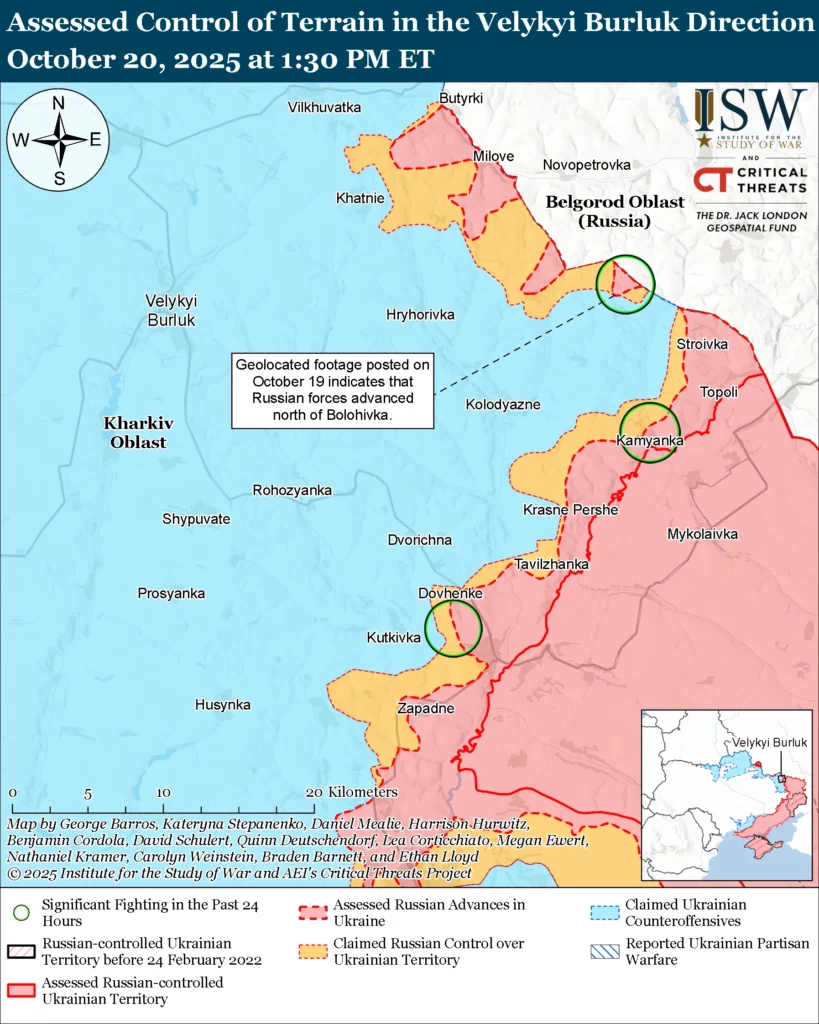
Assessed Russian advances: Geolocated footage published on October 20 indicates that Russian forces recently advanced north of Bolohivka (east of Velykyi Burluk).[37]
Unconfirmed claims: Russian milbloggers claimed that Russian forces advanced near Ambarne (northeast of Velykyi Burluk) and Odradne (east of Velykyi Burluk) and toward Khatnie (northeast of Velykyi Burluk).[38]
Russian forces attacked east of Velykyi Burluk near Bolohivka on October 20.[39]
Russian Subordinate Main Effort #2
Russian objective: Capture the remainder of Luhansk Oblast and push westward into eastern Kharkiv Oblast and encircle northern Donetsk Oblast
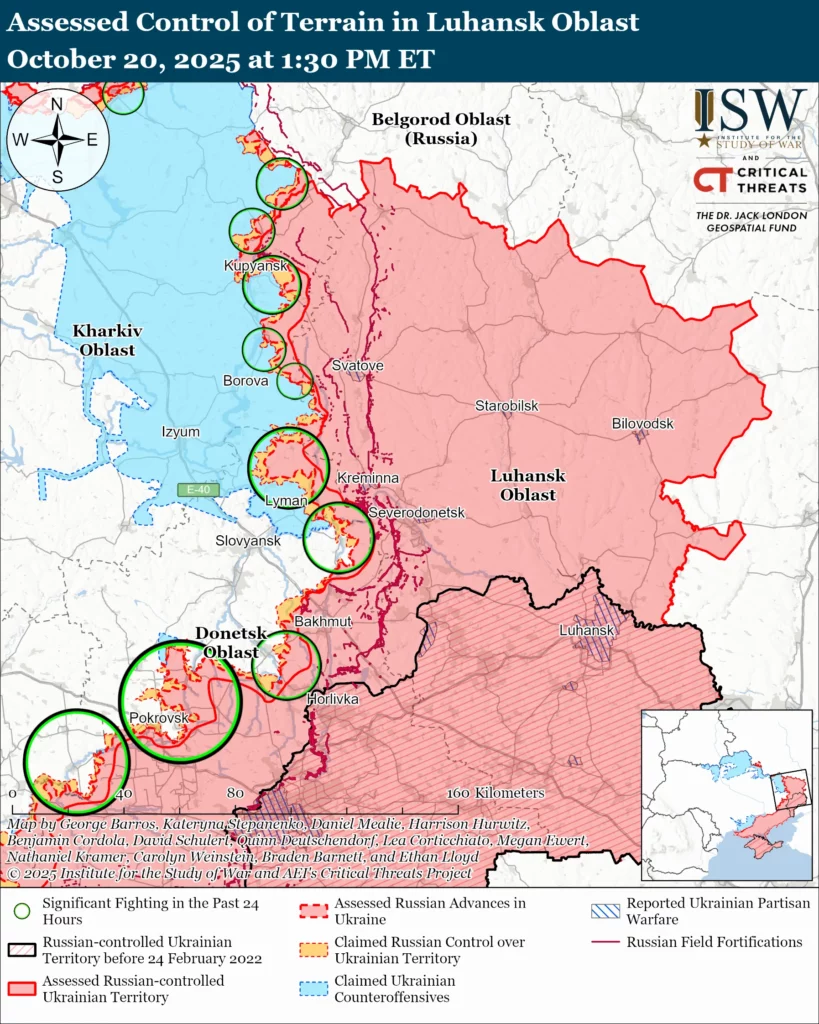
Ukrainian forces maintained positions or recently advanced in the Kupyansk direction.
Refinement of areas under Russian claims: Geolocated footage published on October 18 indicates that Ukrainian forces maintain positions or recently advanced in central Kupyansk — an area in which Russian sources previously claimed that Russian forces maintained a presence.[40]
Unconfirmed claims: A Russian milblogger claimed that Russian forces advanced west of and within central Kupyansk and north of Kucherivka (east of Kupyansk).[41] Russian forces attacked near and within Kupyansk itself; northeast of Kupyansk near Dvorichanske and Kamyanka; and southeast of Kupyansk near Stepova Novoselivka and Pishchane on October 19 and 20.[42]
An officer of a Ukrainian battalion operating in the Kupyansk direction reported on October 20 that Russian forces operating in small groups of one to two soldiers are attempting to infiltrate between Ukrainian positions.[43] The officer stated that Russian forces are moving across open terrain but are using thermal imaging cloaks for camouflage and are moving slowly, only covering about one and a half kilometers per hour, to make it more difficult for Ukrainian forces to notice them. The Russian Ministry of Defense (MoD) claimed on October 20 that Russian forces conducted a Geran-2 drone strike against Ukrainian positions near Seredyi Burluk (northwest of Kupyansk).[44]
Order of Battle: Drone operators of the Russian 68th Motorized Rifle Division (6th Combined Arms Army [CAA], Leningrad Military District [LMD]) are reportedly striking Ukrainian forces near Kupyansk.[45] Drone operators of the 4th Tank Division (1st Guards Tank Army [GTA], Moscow Military District [MMD]) are reportedly operating in the Kupyansk direction.[46]
Ukrainian forces maintained positions or recently advanced in the Borova direction.
Refinement of areas under Russian claims: Geolocated footage published on October 19 indicates that Ukrainian forces maintain positions or recently advanced west of Novovodyane (southeast of Borova) — an area in which Russian sources previously claimed that Russian forces maintained a presence.[47]
Unconfirmed claims: A Russian milblogger claimed that Russian forces advanced northwest of Novoyehorivka (southeast of Borova).[48]
Russian forces attacked north of Borova near Bohuslava on October 20.[49]
Order of Battle: Drone operators of the Russian Viking Drone Detachment of the 252nd Motorized Rifle Regiment (3rd Motorized Rifle Division, 20th CAA, MMD) are striking Ukrainian positions west of Novovodyane.[50]
Russian forces continued offensive operations in the Lyman direction but did not make confirmed advances.
Unconfirmed claims: Russian milbloggers claimed that Russian forces advanced east of Lyman, west of Shandryholove, and in northern Karpivka (both northwest of Lyman).[51]
Russian forces attacked northwest of Lyman near Drobysheve, Shandryholove, Novoselivka, and Serednie and toward Yarova; north of Lyman near Stavky; northeast of Lyman near Myrne; east of Lyman near Zarichne; and southeast of Lyman near Yampil on October 19 and 20.[52]
A Russian milblogger claimed that Russian forces leveraged Russian strikes from Kolodyazi (northeast of Lyman) and Yampil to advance in and near Myrne (southeast of Kolodyazi and north of Yampil).[53] The milblogger claimed that central Yampil remains a contested ”gray zone.” Another Russian milblogger claimed that the claimed Russian seizure of Myrne and the nearby dam allows Russian forces to freely enter Zarichne (just south of Myrne).[54]
Order of Battle: Drone operators of the Russian Rubikon Center for Advanced Unmanned Technologies are reportedly striking Ukrainian forces in the Lyman direction.[55]
Russian Subordinate Main Effort #3
Russian objective: Capture the entirety of Donetsk Oblast, the claimed territory of Russia’s proxies in Donbas, and advance into Dnipropetrovsk Oblast
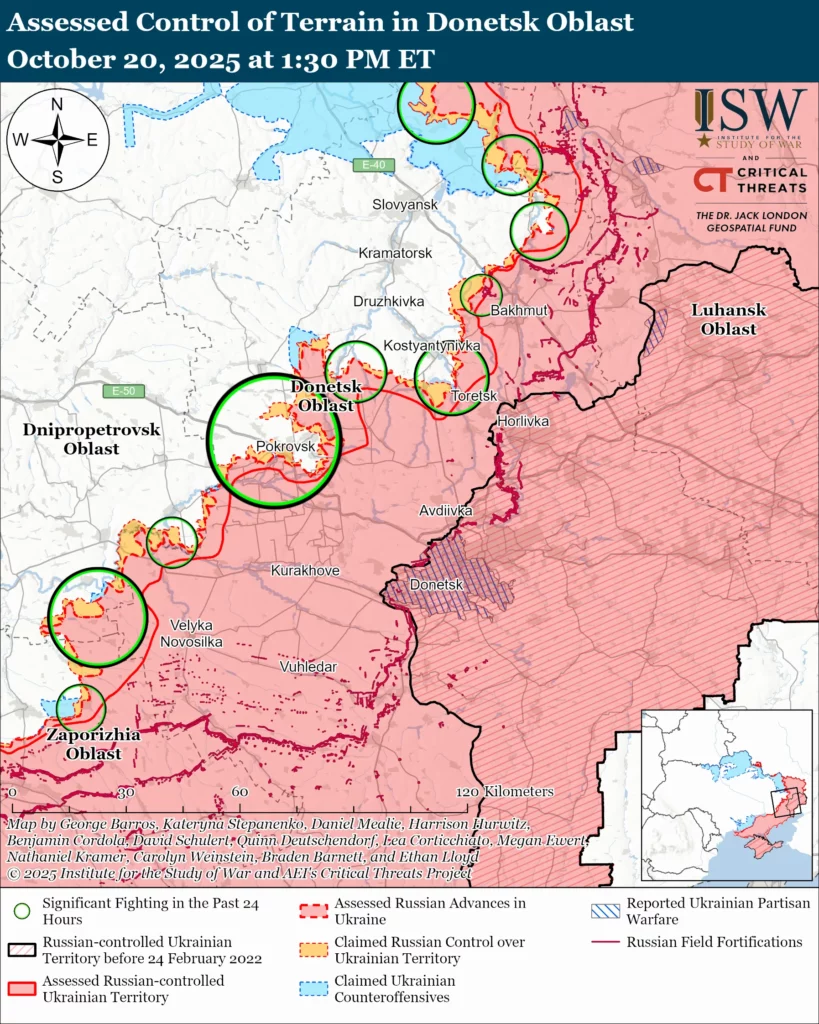
Ukrainian forces recently advanced in the Siversk direction.
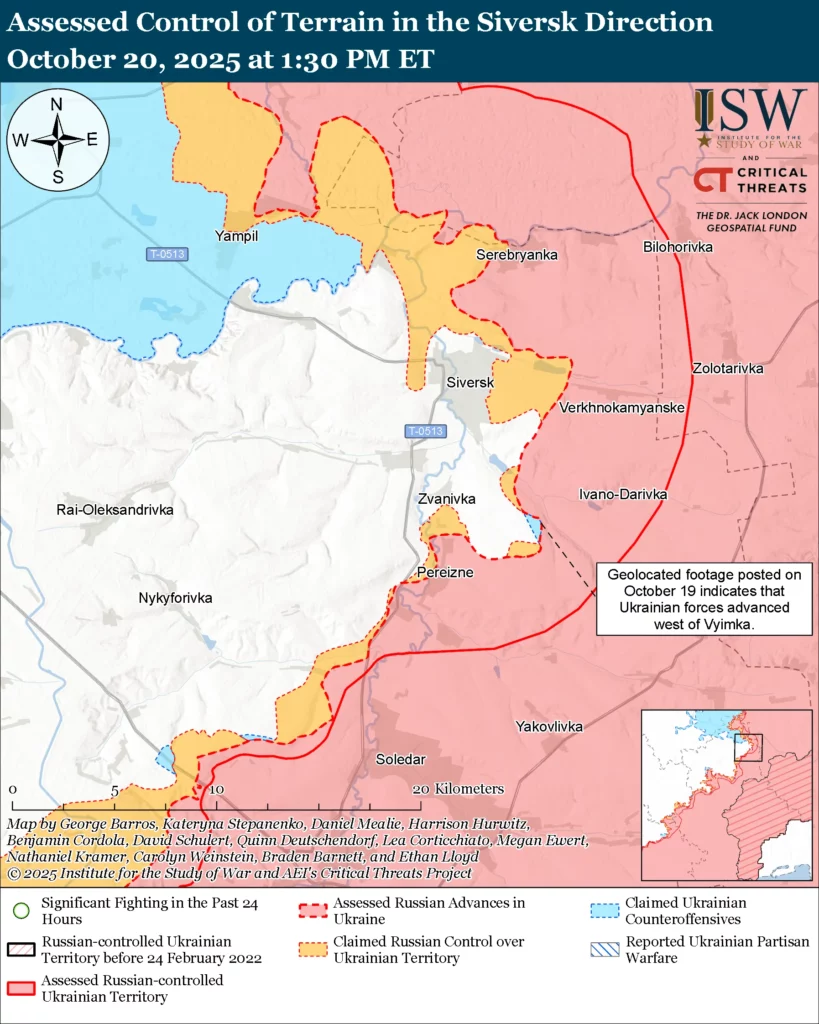
Assessed Ukrainian advances: Geolocated footage published on October 19 indicates that Ukrainian forces recently marginally advanced along the Donetska railroad west of Vyimka (southeast of Siversk).[56]
Unconfirmed claims: Russian milbloggers claimed that Russian forces advanced east of Kuzmynivka (south of Siversk) and south of Vasyukivka (southwest of Siversk).[57]
Russian forces attacked near Siversk itself, northwest of Siversk near Dronivka, northeast of Siversk near Serebryanka, southeast of Siversk near Vyimka, south of Siversk near Pereizne and Zvanivka, and southwest of Fedorivka on October 19 and 20.[58]
Order of Battle: Drone operators of the Russian 123rd Motorized Rifle Brigade (3rd Combined Arms Army [CAA], formerly 2nd Luhansk People’s Republic Army Corps [LNR, AC], Southern Military District [SMD]) are reportedly striking Ukrainian positions west of Vyimka.[59] Artillery elements of the 2nd Artillery Brigade (3rd CAA) are reportedly striking Ukrainian positions near Zvanivka.[60]
Russian forces continued offensive operations in the Kostyantynivka-Druzhkivka tactical area on October 20 but did not make confirmed advances.
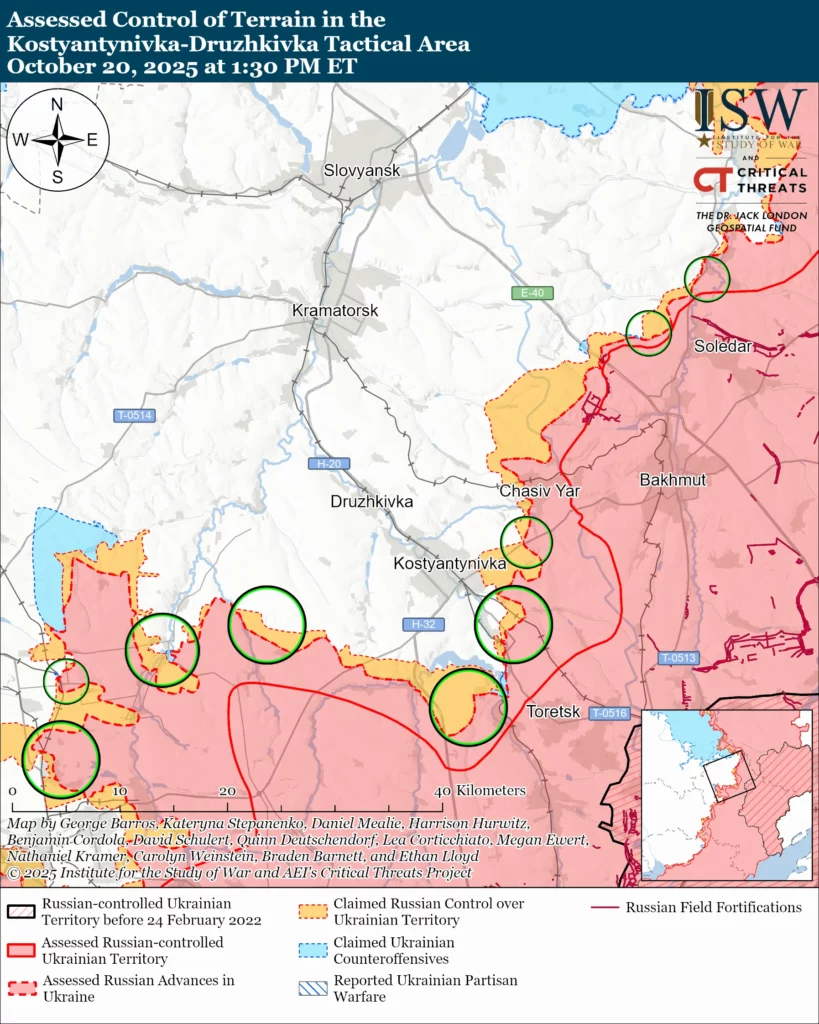
Unconfirmed claims: Donetsk People’s Republic (DNR) Head Denis Pushilin claimed that Russian forces are entering Kostyantynivka.[61]
Russian forces attacked near Kostyantynivka itself; northeast of Kostyantynivka near Chasiv Yar; east of Kostyantynivka near Stupochky; southeast of Kostyantynivka near Oleksandro-Shultyne; south of Kostyantynivka near Katerynivka; southeast of Kostyantynivka near Toretsk, Pleshchiivka, and Shcherbynivka; south of Druzhkivka near Rusyn Yar and Poltavka; and southwest of Druzhkivka near Volodymyrivka and Sofiivka on October 19 and 20.[62] Russian milbloggers claimed that Ukrainian forces counterattacked in Volodymyrivka.[63]
Order of Battle: Elements of the Russian 6th Motorized Rifle Division (3rd AAC, under the operational control of the Southern Grouping of Forces) are reportedly operating between Stupochky and Bila Hora (south of Stupochky).[64] Drone operators of the 68th Separate Reconnaissance Battalion of the 20th Motorized Rifle Division (8th CAA, SMD) are reportedly striking Ukrainian forces near Raiske (southwest of Druzhkivka) and Staroraiske (west of Druzhkivka).[65] Drone operators of the Smuglyanka Detachment are reportedly striking Ukrainian forces near Kostyantynivka.[66] Drone operators of the Berkut Group of the 238th Artillery Brigade (8th CAA, SMD) are reportedly striking Ukrainian forces near Kostyantynivka.[67]
Russian forces continued offensive operations in the Dobropillya tactical area on October 20 but did not make confirmed advances.
Unconfirmed claims: Russian milbloggers claimed that Russian forces seized Shakhove and advanced southwest and southeast of Shakhove and in central Novyi Donbas (both east of Dobropillya).[68]
Russian forces attacked east of Dobropillya near Nove Shakhove and Shakhove and southeast of Dobropillya near Zapovidne and Dorozhnie on October 19 and 20.[69] A Russian milblogger claimed that Ukrainian forces counterattacked near Shakhove.[70]
A Russian milblogger claimed that Russian forces conducted guided glide bomb strikes against Shakhove on the night of October 18 to 19 after initial assaults on the settlement were unsuccessful.[71] The milblogger claimed that the strikes allowed unspecified Russian naval infantry forces to then seize Shakhove but that small Ukrainian groups maintain a presence in the settlement.
Russian forces continued offensive operations in the Pokrovsk direction on October 20 but did not make confirmed advances.
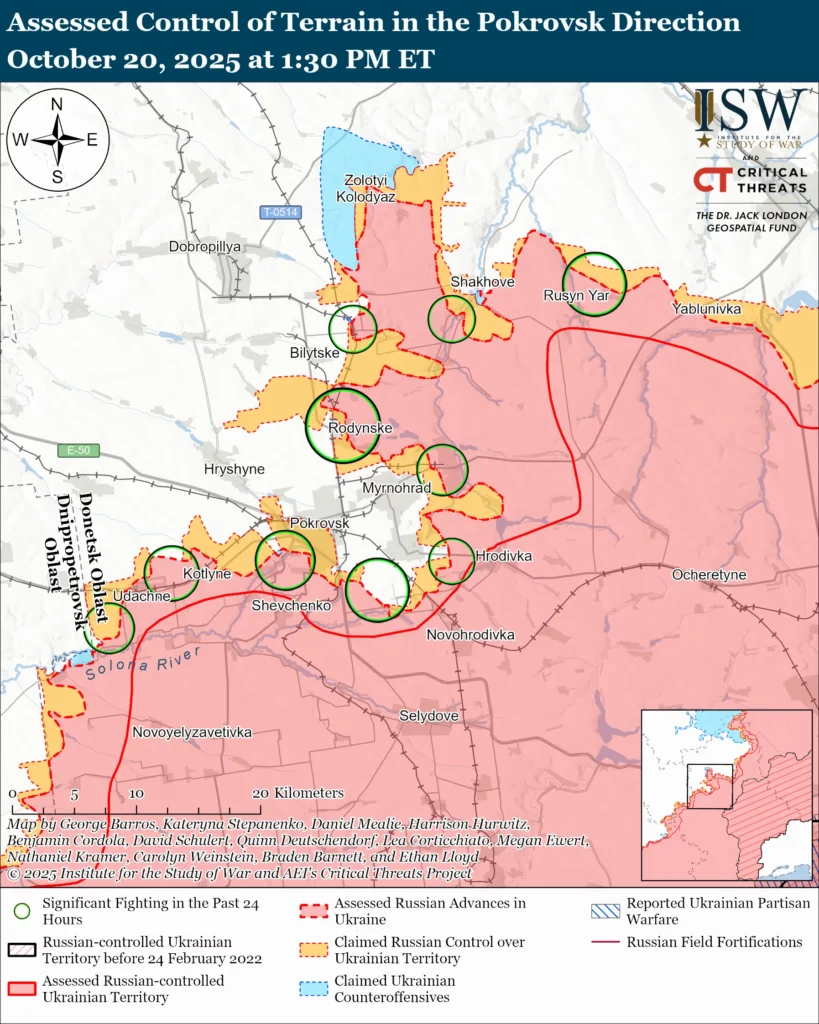
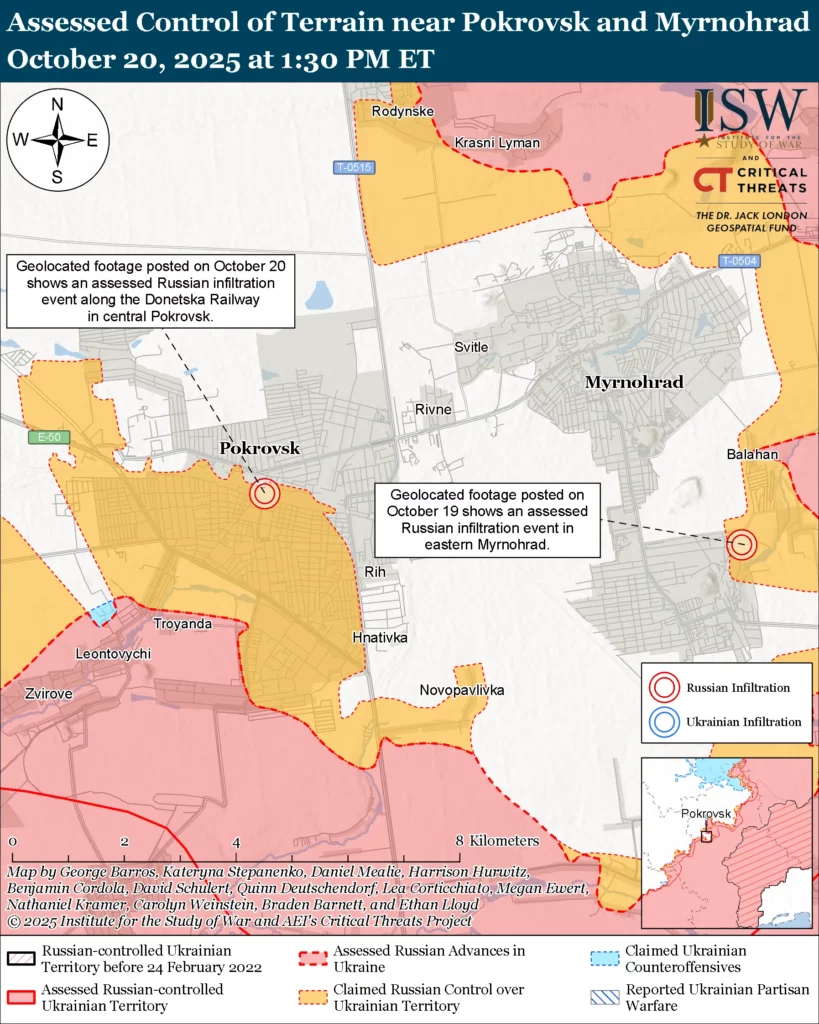
Unconfirmed claims: Russian milbloggers claimed that Russian forces advanced in western, northwestern, northern, eastern and central Pokrovsk; in central Rodynske (north of Pokrovsk); southwest of Krasnyi Lyman (northeast of Pokrovsk); in eastern Myrnohrad (east of Pokrovsk); southwest of Kozatske (east of Pokrovsk); northwest, north, and east of Novopavlivka (south of Pokrovsk); north and northwest of Udachne (southwest of Pokrovsk); and north of Molodetske (southwest of Pokrovsk).[72] The Russian Ministry of Defense (MoD) claimed on October 20 that Russian forces seized Molodetske.[73]
Russian forces attacked near Pokrovsk itself; north of Pokrovsk near Rodynske; northeast of Pokrovsk near Krasnyi Lyman, Kozatske, and Novoekonomichne; east of Pokrovsk near Myrnohrad, Balahan, and Promin; southeast of Pokrovsk near Lysivka and Sukhyi Yar; and southwest of Pokrovsk near Kotlyne, Zvirove, Molodetske, and Udachne on October 19 and 20.[74] A Russian milblogger claimed that Ukrainian forces counterattacked near Balahan, Kozatske, and Fedorivka (northeast of Pokrovsk).[75]
Geolocated footage published on October 19 shows Ukrainian forces striking Russian positions in a building along Postysheva Street in eastern Myrnohrad after Russian forces conducted what ISW assesses was an infiltration mission.[76] Geolocated footage published on October 20 shows Ukrainian forces striking a Russian position in eastern Pokrovsk and along a railroad in central Pokrovsk after what ISW assesses were Russian infiltration missions.[77] ISW assesses that these infiltration missions did not change the control of terrain or the forward edge of the battle area (FEBA) at this time. The Ukrainian 7th Rapid Reaction Corps of the Air Assault Forces reported on October 20 that Russian sabotage and reconnaissance groups penetrated central Pokrovsk and killed several civilians near the railway station.[78] The corps reported that Ukrainian forces eliminated the group hiding in the railway station and have destroyed 14 Russian soldiers who entered Pokrovsk in the past two days. The corps reported that Russian forces are trying to expand the contested “gray zone” within Pokrovsk and to penetrate the settlement from several directions.
Ukrainian military observer Kostyantyn Mashovets stated that Russian forces had advanced to the eastern outskirts of Myrnohrad but that Ukrainian drone operators have been clearing the area over the past two to three days.[79] Mashovets stated that the Russian military command has attached elements of as many as six to seven Russian regiments and battalions of the mobilization reserves to the units and formations operating in the Pokrovsk direction as reinforcements.[80] Mashovets stated that these mobilization reserves elements mostly act as forward assault infantry. Russian milbloggers claimed that Russian forces occupy about half of Rodynske but that Ukrainian forces maintain positions in the settlement.[81] A milblogger claimed that Ukrainian observation posts in high-rises in Rodynske are complicating Russian advances in the area.[82]
Order of Battle: Mashovets stated that elements of the Russian 15th and 30th motorized rifle brigades and the 385th Artillery Brigade (all three of the 2nd CAA, Central Military District [CMD]) are operating in the Pokrovsk direction.[83] Mashovets stated that elements of the 5th and 9th motorized rifle brigades (both of the 51st CAA, formerly 1st Donetsk People’s Republic [DNR] AC, SMD) and possibly elements of the 1st Motorized Rifle Brigade (51st CAA) are operating near Myrnohrad. Mashovets stated that elements of the 1st, 5th, and 110th motorized rifle brigades (all three of the 51st CAA) and possibly of the 39th Motorized Rifle Brigade (68th AC, Eastern Military District [EMD]) are operating near Rodynske.[84] Mashovets stated that elements of the 5th and 9th motorized rifle brigades and 72nd Spetsnaz Battalion (reportedly of the 3rd AC) are conducting infiltration missions near Balahan and Kozatske.[85] Mashovets stated that elements of the 27th Motorized Rifle Division (2nd CAA, CMD) are operating south of Pokrovsk and within southern Pokrovsk.[86] Mashovets stated that elements of the 15th Motorized Rifle Brigade (2nd CAA) and 1441st Motorized Rifle Regiment (likely comprised of mobilized personnel) are operating near Kotlyne. Elements of the 55th Motorized Rifle Brigade (41st CAA, CMD) and 1452nd Motorized Rifle Regiment (operationally subordinated to the 74th Motorized Rifle Brigade, 41st CAA) are reportedly responsible for the claimed seizure of Novopavlivka.[87]
Russian forces continued offensive operations in the Novopavlivka direction on October 20 but did not advance.
Russian forces attacked near Novopavlivka itself; southeast of Novopavlivka near Dachne; south of Novopavlivka near Filiya and near Zaporizhzhia on October 19 and 20.[88]
Order of Battle: Drone operators of the Russian 1444th Motorized Rifle Regiment (74th Motorized Rifle Brigade, 41st CAA, CMD) are reportedly striking Ukrainian forces in Novopavlivka.[89] Drone operators of the Rubikon Center for Advanced Unmanned Technologies and Smuglyanka Detachment are reportedly guiding Russian Aerospace Forces (VKS) strikes against Novopidhorodne (northeast of Novopavlivka).[90]
Russian forces continued offensive operations in the Velykomykhailivka direction on October 20 but did not make confirmed advances.
Unconfirmed claims: A Russian milblogger claimed that Russian forces advanced north of Verbove (southwest of Velykomykhailivka).[91]
Russian forces attacked northeast of Velykomykhailivka near Andriivka-Klevtsove; east of Velykomykhailivka near Oleksandrohrad; southeast of Velykomykhailivka near Sichneve, Sosnivka, and Vorone; south of Velykomykhailivka near Kalynivske and toward Orestopil; and southwest of Velykomykhailivka near Vyshneve, Verbove, Yehorivka, and Oleksiivka and toward Vovche on October 19 and 20.[92] A Russian milblogger claimed that Ukrainian forces counterattacked near Stepove (south of Velykomykhailivka).[93]
Russian milbloggers claimed that Russian VKS struck a road bridge west of Dobropasove (west of Velykomykhailivka) with four guided FAB-500 bombs.[94] A Russian source claimed that elements of the Russian 16th Radiation, Chemical, and Biological Defense Brigade (EMD) started using fiber optic drones in the Vremivka (Velykomykhailivka) direction.[95]
Russian Supporting Effort: Southern Axis
Russian objective: Maintain frontline positions, secure rear areas against Ukrainian strikes, and advance within tube artillery range of Zaporizhzhia City
Russian forces continued limited ground attacks in the Hulyaipole direction on October 20 but did not make confirmed advances.
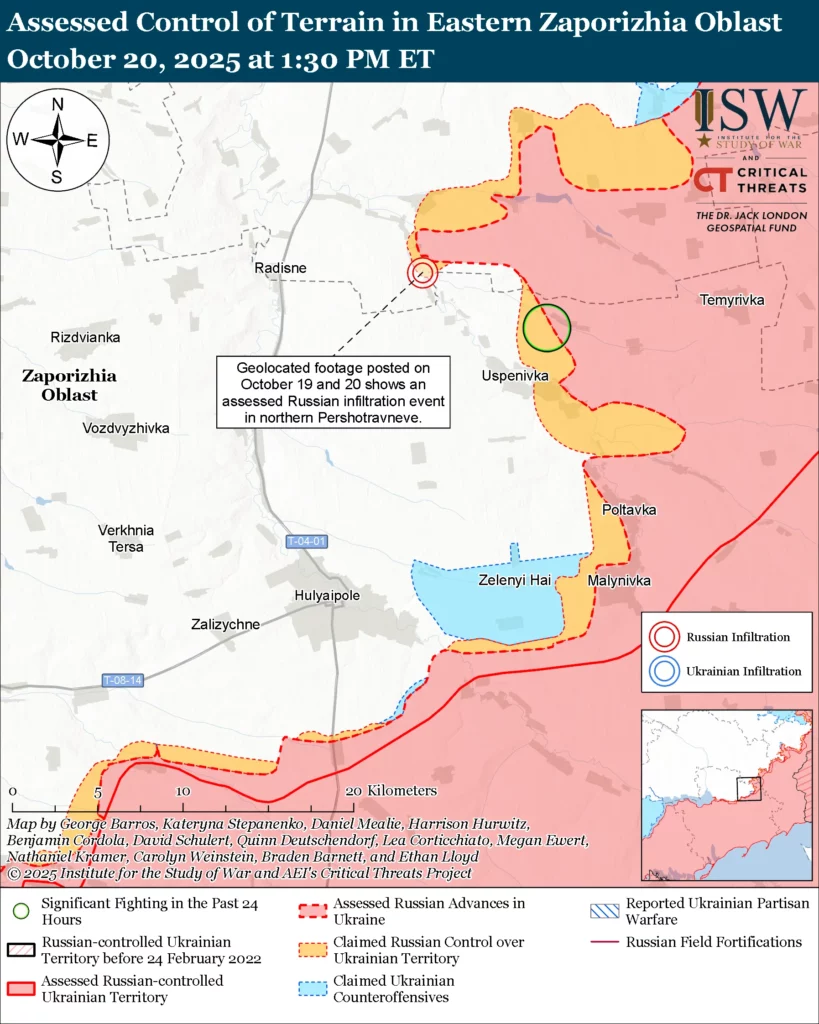
Unconfirmed claims: Russian milbloggers claimed that Russian forces advanced in northern Pershotravneve (north of Hulyaipole), north of Pavlivka (northeast of Hulyaipole), west of Poltavka, and east of Zelenyi Hai (both east of Hulyaipole).[96]
Geolocated footage published on October 19 and 20 shows a Russian servicemember raising a flag in northern Pershotravneve, likely as part of a Russian infiltration mission.[97] ISW assesses that this event did not change the control of terrain or the forward edge of the battle area (FEBA).
Russian forces conducted attacks northeast of Hulyaipole near Olhivske, Novohryhorivka, and Novomykolaivka and toward Pryvilne and east of Hulyaipole near Malynivka on October 19 and 20.[98]
Order of Battle: Elements of the Russian 57th Motorized Rifle Brigade (5th Combined Arms Army [CAA], Eastern Military District [EMD]) are reportedly operating near Poltavka and Okhotnyche (northeast of Hulyaipole).[99] Elements of the 11th Air Force and Air Defense Army (Russian Aerospace Forces [VKS] and EMD) are reportedly striking Ukrainian positions near Dolynka (northwest of Hulyaipole).[100]
Russian forces recently conducted a battalion-sized mechanized assault in western Zaporizhia Oblast.
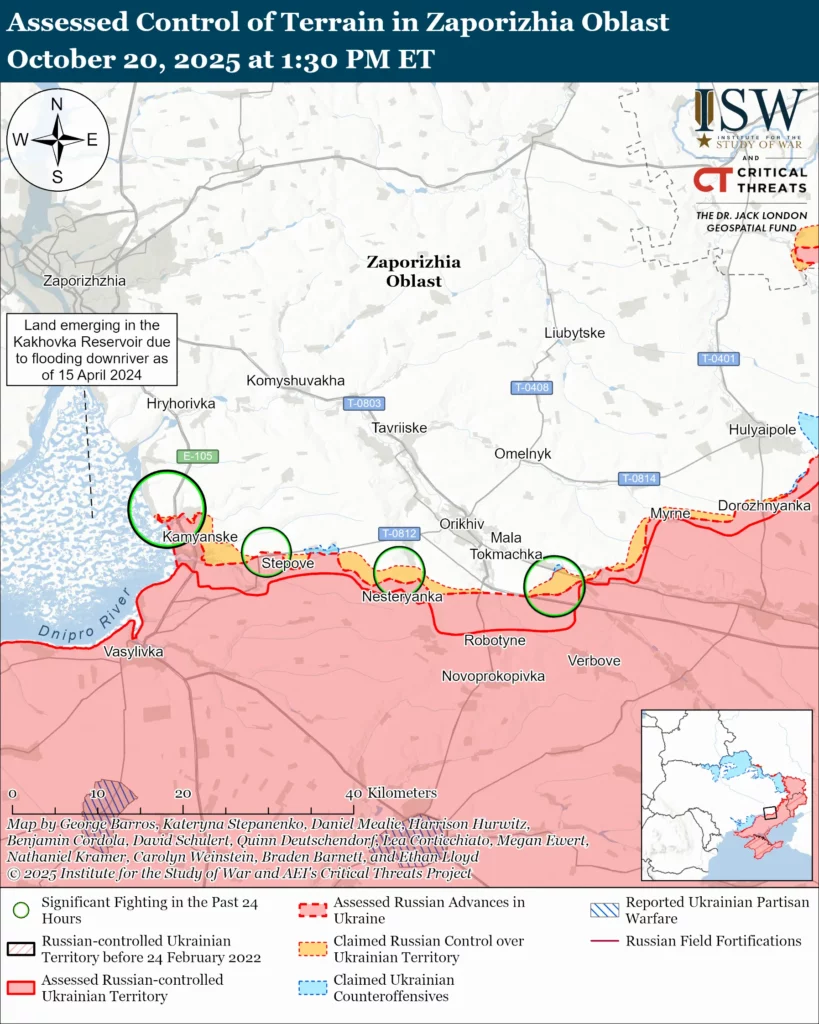
Unconfirmed claims: A Russian milblogger claimed that Russian forces advanced south of Stepnohirsk (west of Orikhiv).[101]
Russian forces attacked southeast of Orikhiv near Mala Tokmachka; south of Orikhiv near Novodanylivka; southwest of Orikhiv near Nesteryanka; and west of Orikhiv near Novoandriivka, Stepnohirsk, Plavni, and Prymorske on October 19 and 20.[102] A Russian milblogger claimed that Ukrainian forces counterattacked in Prymorske and Stepnohirsk.[103]
Ukrainian Southern Defense Forces Spokesperson Colonel Vladyslav Voloshyn reported on October 20 that Russian forces launched a battalion-sized mechanized assault with artillery and drone support near Shcherbaky, Novodanylivka, Nesteryanka, and Mala Tokmachka.[104] Voloshyn stated that the Russian assault consisted of 150 infantrymen and 30 vehicles, including five tanks, five unspecified armored fighting vehicles (AFVs), and an unspecified number of armored personnel carriers (APCs), all-terrain vehicles (ATVs), and motorcycles. Voloshyn stated that fighting continues but that Ukrainian forces have already destroyed at least 10 Russian vehicles. Voloshyn noted that Russian forces have not conducted large mechanized assaults in the Orikhiv direction since late summer 2025.
Order of Battle: Drone operators of the Russian 7th Airborne (VDV) Division reportedly continue to strike Ukrainian forces in the Prymorske-Stepnohirsk area.[105]
Russian forces continued limited attacks in the Kherson direction but did not advance.
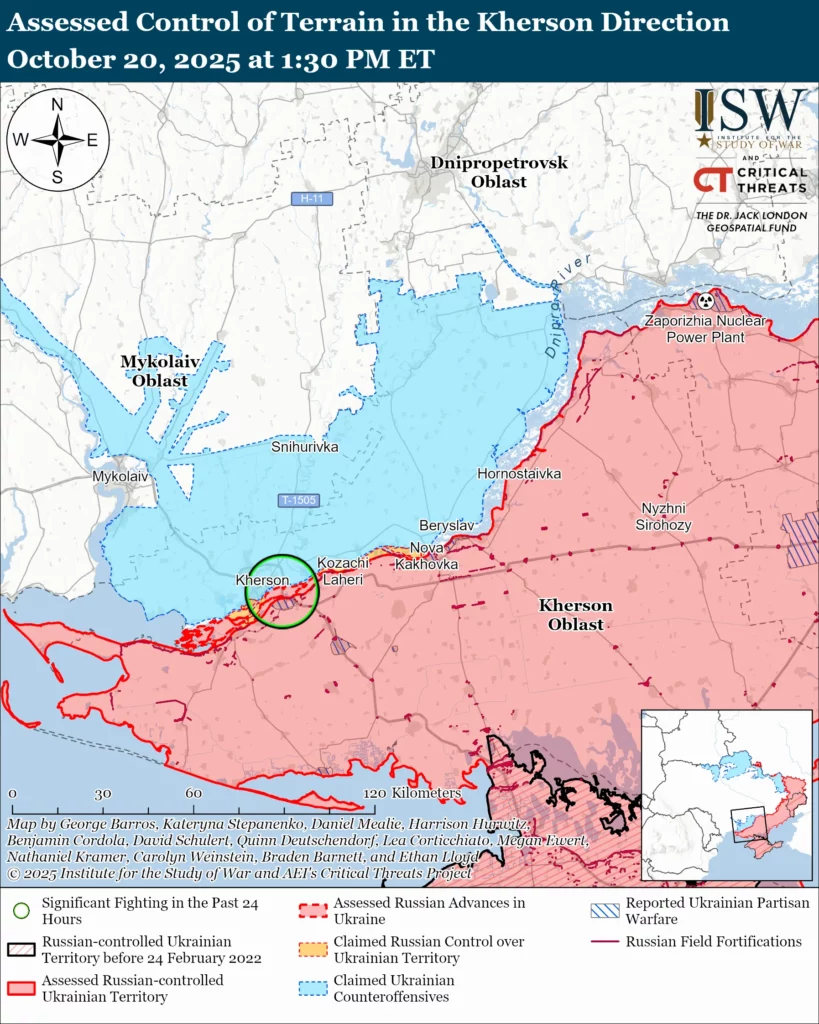
Russian forces continued limited attacks east of Kherson City near the Antonivskyi roadway and railway bridges on October 19 and 20.[106]
A Russian milblogger claimed on October 19 that an unspecified number of Russian sabotage and reconnaissance groups are operating in west (right) bank Kherson Oblast near Antonivka and Prydniprovske (both east of Kherson City) and that Ukrainian forces began to withdraw from Sadove (immediately northeast of Prydniprovske).[107] The milblogger claimed that these Russian forces aim to establish a bridgehead from which to launch further operations in west bank Kherson Oblast. ISW has not observed visual confirmation or credible sources corroborating the milblogger’s claims. ISW continues to assess that the Kremlin is undertaking an informational effort to falsely portray limited Russian offensive operations in the Kherson direction as a larger offensive effort against west bank Kherson Oblast, an assessment that is not inconsistent with the operations of small Russian groups on the west bank.[108]
Ukrainian forces recently struck a Russian radar system in occupied Crimea.
Geolocated footage from Ukraine’s Main Military Intelligence Directorate (GUR) published on October 20 shows a Ukrainian drone strike against a Valdai radar station, which detects and downs small drones, at the Dzhankoi Airfield in occupied Crimea.[109]
Russian Air, Missile, and Drone Campaign
Russian Objective: Target Ukrainian military and civilian infrastructure in the rear and on the front line
Russian forces conducted a series of missile and drone strikes against Ukraine on the night of October 19 and 20. The Ukrainian Air Force reported that Russian forces launched three Iskander-M/KN-23 ballistic missiles from occupied Crimea and 60 Shahed-type, Gerbera-type, and other drones – about 40 of which were Shahed-type drones – from the directions of Oryol City; Millerovo, Rostov Oblast; Primorsko-Akhtarsk, Krasnodar Krai; and occupied Cape Chauda, Crimea.[110] The Ukrainian Air Force reported that Ukrainian forces downed 38 drones and that the three ballistic missiles and 20 drones hit 12 locations. Ukrainian officials reported that Russian drone strikes struck rail, port, agricultural, energy, and civilian infrastructure in Kharkiv, Chernihiv, Dnipropetrovsk, and Odesa oblasts.[111] Chernihiv Oblast officials reported that the Russian strikes left tens of thousands of consumers in Chernihiv Oblast without electricity.[112]
Ukraine’s largest private energy company, DTEK, reported on October 19 that Russian forces struck a DTEK coal mine in Dnipropetrovsk Oblast, trapping 192 employees underground.[113] DTEK reported that this was the fourth large-scale Russian strike on a DTEK coal enterprise since August 2025.
Ukrainian Deputy Energy Minister Mykola Kolisnyk stated on October 20 that Russian forces are conducting a more coordinated strike campaign compared to fall-winter 2024.[114] Kolisnyk reported that Russians forces would strike a broad target set of energy facilities during a strike series in 2024, but that Russian forces began limiting their target set to specific regions and facilities in fall 2025. Kolisnyk stated that Russian strikes aim to destroy simultaneously elements of the Ukrainian electricity production, transmission, and distribution systems and air defenses protecting energy facilities. Kolisnyk reported that the frequent Russian strikes make it difficult for Ukraine to restore its energy facilities. Ukrainian Main Military Intelligence Directorate (GUR) Deputy Head Major General Vadym Skibitsky stated that heavy Russian strikes against Chernihiv and Sumy oblasts aim to create a “sanitary” buffer zone in these oblasts by depriving Ukrainians of electricity, heat, and other services and driving civilians from these oblasts.[115]
The Ukrainian Air Force reported that Russian forces launched a glide bomb from airspace over Kharkiv Oblast at Poltava Oblast on October 20, and Ukrainian media characterized the launch as the first time that Russian forces launched a glide bomb at Poltava Oblast.[116] Russian forces have recently been launching new longer-range glide bombs at areas in northern Ukraine, particularly Kharkiv Oblast.[117] Ukrainian electronic and radio warfare expert Serhiy “Flash” Beskrestnov reported that the new Russian UMPB-5 precision guided glide bomb has a similar shape to a cruise missile, must be dropped from a height of at least 10 kilometers, has a maximum range of 200 kilometers, and has a 100-kilogram payload.[118] Beskrestnov stated that the UMPB-5 has a longer range because it has an engine to propel it forward in flight. Beskrestnov stated that the UMPB-5 is too fast for Ukrainian forces to down with interceptor drones and that the effect of Ukrainian electronic warfare (EW) on it is unclear. Beskrestnov stated that the UMPB-5 is different from the Grom-1 and Grom-2 glide bombs, which are based on the Russian Kh-38 air-to-surface missile. A Russian milblogger claimed that the Grom-1 and Grom-2 glide bombs have estimated ranges of 200 to 500 kilometers and that recent tests show that these UMPB-5 glide bombs have a range of up to 193 kilometers.[119] A Russian milblogger purporting to be a Su-34 fighter jet pilot claimed that Russian forces will “soon” field new glide bombs with a range of over 200 kilometers.[120]
Significant Activity in Belarus
Russian efforts to increase its military presence in Belarus and further integrate Belarus into Russian-favorable frameworks
The Belarusian Ministry of Defense (MoD) announced that the Collective Security Treaty Organization (CSTO) Indestructible Brotherhood-2025 and Barrier-2025 military exercises began in Tajikistan on October 20.[121] Military contingents from Russia, Belarus, Kazakhstan, Kyrgyzstan, and Tajikistan are participating.
Belarussian First Deputy Defense Minister and Chief of the General Staff Major General Pavel Muraveiko met with Vietnamese Deputy Defense Minister and Chief of the General Staff Army General Nguyen Tan Cuong and Defense Minister Army General Phan Van Giang and discussed bilateral military cooperation on October 19 and 20.[122]
Note: ISW does not receive any classified material from any source, uses only publicly available information, and draws extensively on Russian, Ukrainian, and Western reporting and social media as well as commercially available satellite imagery and other geospatial data as the basis for these reports. References to all sources used are provided in the endnotes of each update.
 Eurasia Press & News
Eurasia Press & News




